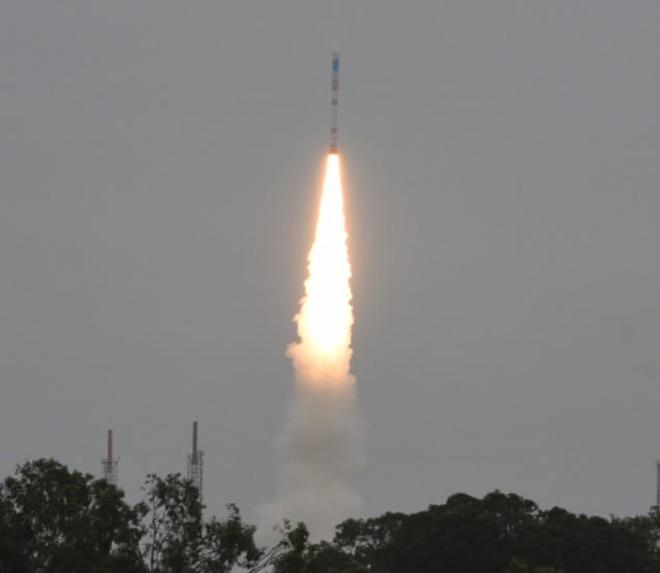ISRO’s maiden Small Satellite Launch Vehicle (SSLV), carrying Earth Observation Satellite (EOS-02) and a student-made satellite-AzaadiSAT, lifted off from the Sriharikota spaceport at 9:18 a.m.
The countdown for the launch of India’s maiden SSLV commenced at 2.26 a.m. on Sunday, the Indian Space Research Organisation (ISRO) said. The objective of the SSLV was to place satellites EOS-02 and AzaadiSAT into low earth orbit.
Here are the updates:
Satellites no longer usable after deviation: ISRO on its maiden SSLV mission
The ISRO said the satellites onboard its maiden Small Satellite Launch Vehicle “are no longer usable” after the SSLV-D1 placed them in an elliptical orbit instead of a circular one.
The space agency said a committee would analyse and make recommendations into today’s episode and with the implementation of those recommendations “ISRO will come back soon with SSLV-D2.” “SSLV-D1 placed the satellites into 356 km x 76 km elliptical orbit instead of 356 km circular orbit. Satellites are no longer usable. Issue is reasonably identified. Failure of a logic to identify a sensor failure and go for a salvage action caused the deviation,” ISRO said in an update on its official Twitter handle.
It added a detailed statement by ISRO Chairman S. Somanath will be “uploaded soon.”
Anxiety among ISRO scientists
A jubilant mood at the Mission Control Centre on Sunday morning soon made way for anxiety as scientists were seen glued to the computer screens and confused, before Mr. Somanath updated the mission status. There has been no official word on whether the mission was successful, as scientists analysed the data from the rocket. So far, there has been no official confirmation on the success of the mission.
Read more here.
ISRO declares SSLV’s maiden flight ‘completed’; data loss being analysed
ISRO to assess data loss in mission; status of satellites to be declared soon
All stages of SSLV performed as expected, but suffered data loss at terminal phase of the mission, says ISRO Chief S. Somanath. “We are analysing the data and will come back on the the status of the satellites as well as the vehicle performance soon”, he said.
SSLV lifts off from Sriharikota

ISRO’s maiden SSLV carrying earth observation and student satellite blasts off from Sriharikota
ISRO’s maiden small satellite launch vehicle (SSLV), carrying earth observation satellite EOS-02 and co-passenger students satellite AzaadiSAT lifted off from the Satish Dawan Space Centre on Sunday. The SSLV-D1/EOS-02 mission by the Indian space agency is aimed at garnering a larger pie in the small launch vehicles market, as it can place the satellites into Low Earth Orbit.
The SSLV can put payloads (mini, micro or nanosatellites) weighing upto 500 kg into the 500 km planar orbit, said ISRO.
At the end of a seven and a half hour countdown, the 34 metre long SSLV soared majestically at 9.18 a.m. amid cloudy skies to place the satellites into the intended orbit. - PTI
ISRO’s ‘baby rocket’ and its umbilical cord with Thiruvananthapuram
When the Small Satellite Launch Vehicle (SSLV) lifts off from Sriharikota on its maiden developmental flight, Thiruvananthapuram, where India’s space programme took off in the 1960s, will have much to cheer about.
Read more here.
What is AzaadiSAT?
AzaadiSAT is a 8U Cubesat weighing around 8 kg. It carries 75 different payloads each weighing around 50 grams and conducting femto-experiments. Girl students from rural regions across the country were provided guidance to build these payloads. The payloads are integrated by the student team of “Space Kidz India”.
Read more here.
Launch scheduled for 9:18 a.m.
What is EOS-02?
EOS-02 is an earth observation satellite designed and realised by ISRO. This microsat series satellite offers advanced optical remote sensing operating in infra-red band with high spatial resolution. The bus configuration is derived from IMS-1 bus. - ISRO (isro.gov.in/)
Countdown to ISRO’s maiden SSLV-D1/EOS-02 mission begins
The lift-off of the rocket is scheduled for 9.18 a.m. from the first launch pad at the Satish Dhawan Space Centre (SHAR) in Sriharikota, about 135 km from Chennai. About 13 minutes after launch, the rocket is expected to place the EOS-02 and AzaadiSAT into the intended orbit.
Unlike ISRO’s trusted workhorse — Polar Satellite Launch Vehicles (PSLV) — the SSLV can carry payloads weighing up to 500 kg and deploy satellites into a 500 km low earth orbit.
It uses solid fuel — hydroxyl terminated polubutadiene — to fire the first three stages which takes the payloads to the desired altitude. The fourth stage comprises liquid propulsion-based Velocity Trimming Module (VTM) to place the satellites into orbit.
The main payload on the 34-metre-tall rocket is the earth observation-02 satellite and co-passenger satellite AzaadiSAT, an 8-kg Cubesat designed by girl students from government schools across the country to mark the 75th anniversary of India’s Independence.
(With inputs from Agencies)







